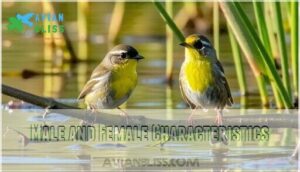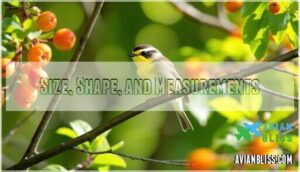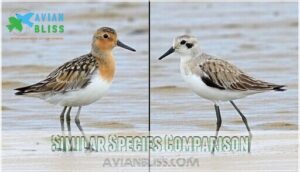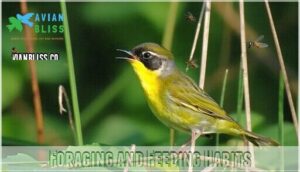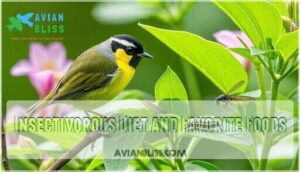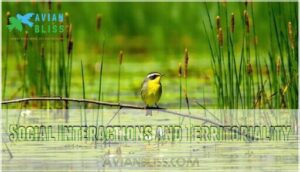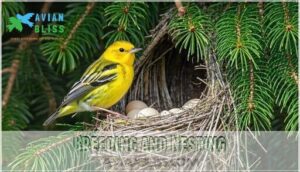This site is supported by our readers. We may earn a commission, at no cost to you, if you purchase through links.
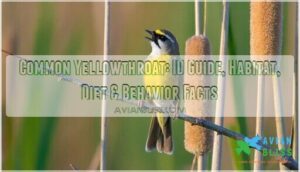
Females sport more subdued olive-brown upperparts with softer yellow coloring. These compact 0.3-ounce warblers inhabit dense vegetation around marshes and wetlands, where males belt out their distinctive "witchity-witchity" songs from hidden perches.
Their chunky build, rounded heads, and slightly pointed bills make them perfect for catching insects on the wing. While males flash their superhero-like masks during territory disputes, females blend seamlessly into tangled cattails and willows.
Understanding their habitat preferences and behavioral quirks reveals why these little masked bandits have become such successful survivors.
Table Of Contents
- Key Takeaways
- Common Yellowthroat Identification
- Habitat and Range
- Behavior and Diet
- Breeding and Nesting
- Conservation and Interesting Facts
- Frequently Asked Questions (FAQs)
- Are Common Yellowthroats rare?
- How to attract a Common Yellowthroat?
- Where do Common Yellowthroats live?
- What does a Common Yellowthroat look like?
- What are the differences between male and female common yellowthroats?
- How big is their territory?
- Are they endangered?
- What do they eat?
- Where do they build their nests?
- What time of day are yellowthroats most active?
- Conclusion
Key Takeaways
- You’ll identify males by their bold black facial mask bordered with white and bright yellow underparts, while females show olive-brown coloring with subtle yellow throats and no mask
- You’ll find them in dense vegetation near water sources like marshes and wetlands, where they forage for insects by gleaning from leaves and catching prey mid-flight
- You’ll hear their distinctive "witchity-witchity-witchity" song before you see them, as these secretive warblers prefer staying hidden in thick cattails and willows
- You’ll encounter one of North America’s most widespread warblers with stable populations of 77 million individuals, though they face threats from habitat loss and nest parasitism by Brown-headed Cowbirds
Common Yellowthroat Identification
You’ll quickly recognize Common Yellowthroats by their striking appearance and unmistakable song.
Males sport a bold black mask across their eyes with bright yellow underparts, while females display more subdued olive-brown coloring with yellow throats and lack the distinctive facial markings, making them easily identifiable by their unique appearance.
A flash of bright yellow and bold black mask signals the male yellowthroat’s unmistakable presence in the marsh
Male and Female Characteristics
Looking at yellowthroat behavior, you’ll spot clear plumage differences between sexes. Adult males sport that signature black mask bordered by white, while females show olive-brown coloring without any facial markings.
Color patterns make identification straightforward once you know what to look for. The Common Yellowthroat’s wetland habitats play a vital role in their breeding and nesting.
- Male mask variations – Bold black facial mask with distinct white border above
- Female plumage description – Olive-brown upperparts with softer yellow throat and breast
- Sex roles reflected in appearance – Males evolved bright colors for territory defense
- Beak shapes remain similar – Both sexes share short, rounded bills for insect catching
- Common yellowthroat dimorphism – Stark contrast between flashy males and camouflaged females
Distinctive Features and Vocalizations
Beyond basic coloring, you’ll recognize common yellowthroats by their distinctive facial markings and unmistakable vocalizations.
Males sport that signature black mask bordered by white, while females show subtle olive-brown head feathers.
Their warbler songs ring out as "witchity-witchity-witchity" – a rhythmic yellowthroat call that’s hard to miss.
| Feature | Males | Females |
|---|---|---|
| Facial Markings | Black mask with white border | Plain olive-brown face |
| Song Patterns | Loud "witchity" series | Softer chip notes |
| Head Feathers | Contrasting mask pattern | Uniform brown coloring |
The yellowthroat behavior includes singing from concealed perches, making their bird vocalizations easier to hear than see.
Their slightly pointed beak shape helps catch insects on the wing.
These plumage colors and vocal patterns make identification straightforward once you know what to listen for.
Size, Shape, and Measurements
You’ll find the Common Yellowthroat’s compact size makes identification straightforward.
Their chunky, rounded head size sits atop a medium-length tail that’s slightly rounded at the tip.
Weighing just 0.3 ounces, these bird measurements place them between a Ruby-crowned Kinglet and Yellow-breasted Chat.
Their proportional build and bird physical traits create a distinctive silhouette you’ll recognize quickly, with a compact size that makes them easily identifiable.
Similar Species Comparison
Several warbler species can confuse even experienced birders when identifying common yellowthroats. You’ll need sharp eyes for species ID success, as plumage differences and beak shapes separate these warbler types from your target bird.
Here’s your bird comparison checklist for songbird identification:
- Nashville Warbler – Look for the distinctive white eyering and grayer head that common yellowthroats lack entirely
- Wilson’s Warbler – Males sport a solid black cap instead of the yellowthroat’s face mask pattern
- Orange-crowned Warbler – Notice their thinner, more pointed bill compared to yellowthroats’ thicker design
Bird species comparison becomes easier when you focus on these key features during warbler species encounters. To improve your identification skills, study the warbler size charts to learn more about the physical characteristics of each species.
Habitat and Range
You’ll find Common Yellowthroats thriving in dense, tangled vegetation near water sources like marshes, wetlands, and brushy swamps across most of North America.
These adaptable warblers breed from southeastern Alaska to central Mexico, with the highest populations concentrated in the Midwest and Northeast, making them one of the continent’s most widespread warbler species.
Preferred Habitats and Vegetation
You’ll find yellowthroats thriving in thick, tangled wetland plants and dense shrubs near water sources.
These secretive birds favor marshes, wetlands, and brushy areas where cattails, willows, and reeds create perfect cover.
Look for them in thicket ecology dominated by marsh vegetation, from prairie potholes to backyard ponds with overgrown edges.
Geographic Distribution Across North America
Common Yellowthroats claim territory across nearly the entire North American continent.
You’ll find Geothlypis trichas from southern Alaska to central Mexico, making it one of North America’s most widespread warblers.
This Maryland yellowthroat inhabits 97% of suitable habitat blocks, demonstrating remarkable adaptability across diverse geographic trends and breeding zones.
Their migration patterns are influenced by bird migration factors.
- Coast-to-coast presence – Found in every U.S. state except Hawaii, proving nature doesn’t believe in boundaries
- 77 million individuals – More yellowthroats than people in most countries, living their best marsh life
- 13 distinct subspecies – Each region’s birds wear slightly different "fashion statements" in their plumage
- Midwest and Northeast hotspots – These areas serve as yellowthroat paradise with incredible population densities
- Sea level to 1,200 meters – From coastal marshes to mountain meadows, they’ve conquered every elevation
Migration Patterns and Seasonal Presence
Most yellowthroats follow major flyway patterns during spring and fall migrations, traveling nocturnal migration routes between breeding and wintering grounds.
These secretive warblers navigate darkness with precision, following ancient flyways that connect marsh to marsh across continents
You’ll spot them at stopover sites throughout migration corridors, with peak seasonal movements occurring in April-May and August-September.
Their warbler migration timing varies by latitude, with northern populations traveling thousands of miles to reach tropical wintering areas.
Behavior and Diet
You’ll find Common Yellowthroats are active foragers that use stealth to stay hidden while hunting insects near the ground.
They glean beetles, caterpillars, and spiders from leaves and low branches, occasionally catching prey mid-flight like tiny aerial acrobats, performing as tiny aerial acrobats.
Foraging and Feeding Habits
You’ll spot these agile warblers employing stealthy movements through dense vegetation, staying concealed while they forage on or near the ground.
They glean insect prey from leaves and bark, perch on grass stalks, and occasionally catch flying insects mid-air through aerial hunting techniques, showcasing their insectivorous nature and ground foraging expertise.
The use of specialized insect catching gear is essential for studying their foraging behaviors in detail.
Insectivorous Diet and Favorite Foods
You’ll find these birds devouring over 90% insect prey during breeding season, with flying insects like moths and beetles topping their menu.
Their insectivorous diet includes caterpillars, grasshoppers, and spiders gathered through gleaning techniques.
Food sources expand to aquatic larvae in marshes, while dietary needs shift seasonally—winter brings seeds and fruits.
Nutrient intake from dozens of daily insects supports their high-energy lifestyle perfectly.
Understanding the importance of a native plant diet is vital for attracting these birds to your yard, with a focus on native plant and seasonal shifts.
Active and Agile Behavior
You’ll notice these warblers move like acrobats through dense vegetation, using quick hops and flutter-jumps between stems.
Their flight patterns stay low and direct, rarely exceeding ten feet high.
Watch how they employ sneaky foraging tactics – freezing mid-motion when sensing danger, then resuming their hunt.
This bird agility helps common yellowthroat navigate thick marshland perfectly.
Their warbler characteristics include tail-flicking and wing-twitching while searching for insects in yellowthroat habitat.
Social Interactions and Territoriality
During breeding season, male Common Yellowthroats establish territories through aggressive displays and their distinctive "witchity-witchity" song.
These polygynous warblers defend prime real estate in dense vegetation, often chasing intruders with fluffed feathers and spread wings.
Males compete fiercely for mate selection, with dominant birds claiming the best wetland spots, which is crucial for their breeding success in competitive warbler communities, and their territorial defense helps guarantee this success.
Breeding and Nesting
You’ll find Common Yellowthroats fascinating during breeding season, when males become fiercely territorial and sing their distinctive "witchity-witchity" song from prominent perches.
The females take charge of nest construction, weaving intricate cups from grasses and bark while dealing with the challenge of Brown-headed Cowbird parasitism.
Mating Systems and Brood Parasitism
Common Yellowthroats embrace polygynous mating systems where males court multiple females through territorial song displays.
However, genetic studies reveal surprising secrets—up to 46% of nests contain extra-pair young from different fathers.
Meanwhile, brownheaded cowbirds create additional challenges through brood parasitism, laying eggs in yellowthroat nests at rates reaching 47%.
Smart females can recognize these foreign eggs, sometimes abandoning parasitized nests entirely.
Nest Building and Female Roles
Female yellowthroats take full responsibility for nest construction, creating cozy cup-shaped structures in dense vegetation.
You’ll observe these skilled architects weaving together natural materials with remarkable precision.
- Grasses, leaves, and strips of bark form the foundation
- Fine rootlets and plant fibers create inner lining
- Sedges and cattail leaves provide outer framework
- Spider silk occasionally binds materials together
The female behavior during nesting shows incredible dedication, often working alone while males focus on territory defense.
The choice of nest building materials is vital for the structure’s stability and camouflage.
Incubation, Broods, and Fledging
After the nest is complete, you’ll observe the female taking on egg incubation duties alone.
She’ll sit on her 3-5 creamy white, spotted eggs for about 12 days, rarely leaving except for quick feeding breaks.
Once hatched, both parents work overtime feeding their hungry chicks. The youngsters develop rapidly, fledging after just 8-10 days.
Many pairs successfully raise two broods per season, maximizing their reproductive success. Understanding bird nesting basics is essential for appreciating the complex behaviors involved in this process, and recognizing the importance of bird nesting.
Predators and Nest Defense
Ground-nesting yellowthroats face constant dangers from Nest Predators lurking below and above.
Snake Attacks pose the greatest threat, while raccoons raid nests nocturnally. Aerial predators like shrikes and hawks strike swiftly from above.
Parents rely on Nest Camouflage and secretive behavior for Brood Defense.
Key predator threats include:
- Ground predators – snakes, raccoons, and opossums target accessible nests
- Aerial hunters – shrikes, kestrels, and merlins attack from above
- Nest parasites – brown-headed cowbirds lay eggs in yellowthroat nests
- Human structures – windows and towers cause migration collisions
Conservation and Interesting Facts
You’ll find the Common Yellowthroat’s conservation story both encouraging and concerning, with populations showing resilience despite facing modern challenges.
While these adaptable warblers maintain stable numbers across most of their range, they’ve experienced a 4% decline in recent years due to habitat loss, window strikes, and nest parasitism by Brown-headed Cowbirds, which is a significant factor in their conservation story.
Population Trends and Conservation Status
Despite recent population decline concerns, you’ll find Common Yellowthroats maintain a stable conservation status.
The IUCN lists them as Least Concern, with 77-87 million individuals globally.
While habitat loss affects local populations, conservation efforts through wetland protection help maintain their widespread distribution.
Bird conservation programs monitor population trends, ensuring these adaptable warblers continue thriving across diverse migration patterns throughout North America.
Understanding the conservation status is essential for developing effective protection strategies for species like the Common Yellowthroat.
Threats and Vulnerability Factors
Common yellowthroats face mounting pressures that threaten their survival across North America.
Habitat Loss from wetland conversion devastates breeding grounds, while Window Collisions kill thousands during nocturnal migration.
Climate Change disrupts precipitation patterns, shrinking vital wetland habitats.
Three major threats demanding attention:
- Nest Parasitism by Brown-headed Cowbirds reaches 47% in some areas
- Predator Avoidance becomes harder as habitat loss forces birds into marginal areas
- Population decline accelerates from pesticide contamination affecting insect prey
These bird threats compound yearly, making conservation status increasingly precarious despite their widespread range.
Longevity and Unique Behaviors
Ten years feels like forever in the wild, yet some common yellowthroat individuals achieve this impressive bird lifespan through remarkable behavioral adaptations.
These warblers develop sophisticated song patterns that improve with age, demonstrating social learning throughout the aging process.
Their migratory strategies become more refined over time, with experienced birds choosing ideal routes, and their diet flexibility and territorial intelligence increase bird longevity substantially, showcasing remarkable adaptations.
Citizen Science and Bird Conservation Efforts
You can make a real difference for yellowthroats through citizen science projects.
Join eBird to report sightings and contribute to Bird Monitoring databases. Participate in Community Engagement initiatives like Christmas Bird Counts or breeding bird surveys.
These Citizen Projects fuel Conservation Research that helps track population trends and inform Wildlife Preservation strategies.
Your observations directly support bird conservation efforts and improve our understanding of this species’ conservation status nationwide.
Effective bird conservation tools are essential for maintaining healthy habitats and ecosystems.
Frequently Asked Questions (FAQs)
Are Common Yellowthroats rare?
You won’t need a birding miracle to spot one—these warblers are widespread across North America.
With their masked look and “witchity” song, you’re way more likely to hear or see them than miss out.
How to attract a Common Yellowthroat?
Create wetland habitat with dense, low vegetation like cattails and willows.
Plant native grasses and shrubs near water sources.
You’ll attract these secretive warblers to marshy areas where they naturally thrive and nest.
Where do Common Yellowthroats live?
Like a patchwork quilt spread across the continent, these masked songbirds inhabit wetlands, thickets, and brushy areas from Alaska to Mexico.
You’ll find them in marshes, willow stands, and dense vegetation near water throughout North America.
What does a Common Yellowthroat look like?
You’ll spot a sparrow-sized songbird with distinctive features.
Males sport bright yellow underparts, a bold black face mask, and olive-brown upperparts.
Females appear plain olive-brown with yellow throat patches, lacking the male’s striking black mask completely.
What are the differences between male and female common yellowthroats?
You’ll spot males with their distinctive black face masks and bright yellow underparts, while females display plain olive-brown coloring with subtle yellow on their throats and undertails—no mask.
How big is their territory?
Male common yellowthroats defend territories of roughly one to three acres during breeding season.
You’ll find they’re quite territorial, vigorously chasing away intruders while singing from prominent perches within their claimed wetland or brushy habitat boundaries, which is a key aspect of their breeding behavior.
Are they endangered?
Riding a wave of resilience, you’ll find these masked songbirds aren’t endangered.
Common yellowthroats maintain stable populations with approximately 77 million adults across North America, earning them "least concern" conservation status despite some local declines.
What do they eat?
Common yellowthroats primarily eat insects like beetles, caterpillars, grasshoppers, and moths, plus spiders.
They’ll glean prey from leaves and bark, occasionally catching insects mid-flight.
Winter brings fruits to supplement their diet, which is a key part of their survival, and they also eat insects.
Where do they build their nests?
You’ll find their nests tucked low in dense vegetation, typically within three feet of the ground.
Females weave grasses, leaves, and bark strips into cup-shaped structures hidden in marshes, thickets, or brushy areas.
What time of day are yellowthroats most active?
Early bird catches the worm applies perfectly here.
You’ll spot yellowthroats most actively during dawn and dusk hours when they’re busily foraging for insects in dense vegetation and singing territorial songs.
Conclusion
Spotting a common yellowthroat becomes straightforward once you know their telltale signs.
These resilient warblers prove that adaptation trumps size—their secretive nature and habitat specialization explain their widespread success across North America.
You’ll find them thriving where dense vegetation meets water, from coastal marshes to prairie potholes.
Whether you’re tracking their distinctive songs or glimpsing that iconic black mask, common yellowthroats reward patient observers with fascinating glimpses into warbler behavior and ecology.

